A harrier is any of the several species of diurnal hawks forming
the Circinae sub-family of the Accipitridae family
of
birds of prey. Harriers characteristically hunt by flying low
over open ground, feeding on small mammals, reptiles, or birds.
Most harriers are placed in the genus Circus,
the scientific name arising from the circling movements female
and male
make when courting. Two other harriers are in the genus Polyboroides,
the harrier-hawks, which are allopatric
(geographically separated) and restricted to the Afrotropic
ecozone. The remaining single species forms the monotypic
genus Geranospiza.
Source: http://en.wikipedia.org/wiki/Harrier_(bird)
|
| Western Marsh-Harrier |
Sivhauk |
Circus
aeruginosus |
| African Marsh-Harrier |
Afrikasivhauk |
Circus
ranivorus |
| Eastern Marsh-Harrier |
Østsivhauk |
Circus
spilonotus |
| Swamp Harrier |
Australsivhauk |
Circus
approximans |
| Reunion Harrier |
Hvitbuksivhauk |
Circus
maillardi |
| Long-winged Harrier |
Langvingekjerrhauk |
Circus
buffoni |
| Spotted Harrier |
Prikkjerrhauk |
Circus
assimilis |
| Black Harrier |
Fynboshauk |
Circus
maurus |
| Cinereous Harrier |
Bendelmyrhauk |
Circus
cinereus |
| Northern
Harrier |
Myrhauk |
Circus
cyaneus |
| Pallid Harrier |
Steppehauk |
Circus
macrourus |
| Pied Harrier |
Praktkjerrhauk |
Circus
melanoleucos |
| Montagu's
Harrier |
Enghauk |
Circus
pygargus |
| Malagasy Harrier |
|
Circus
macrosceles, ex C. maillardi) |
Genus Polyboroides
Madagascar Harrier-Hawk, Polyboroides radiatus
African Harrier-Hawk, Polyboroides typus
Genus Geranospiza
Crane Hawk, Geranospiza caerulescens
Montagu's
Harrier, No: Enghauk, Circus pygargus

Montagu's
Harrier, Circus pygargus
© http://www.ecosystema.ru/
The Montagu's Harrier (Circus pygargus) is a migratory
bird of prey of the harrier family. Its common name commemorates
the British naturalist George Montagu.
 Montagu's
Harrier, Circus pygargus
Montagu's
Harrier, Circus pygargus
© Lubomir Hlasek, www.hlasek.com/ |
Sexual dimorphism is particularly apparent in the plumage of
this species. Adult males are characterized by their
overall pale grey plumage contrasting with black wingtips. Compared
with other harriers this species has
characteristic black bands along the secondaries, both above
and below the wing and rusty streaks on belly and
flanks.
Adult females have a broadly similar plumage to that of Pallid
and Hen Harriers. The underparts are mostly pale
yellow-brown, the belly with longitudinal stripes and the wing
coverts spotted. The upper parts are uniform dark
brown except for the white upper tail coverts ("rump"),
and the sightly paler central wing coverts. |
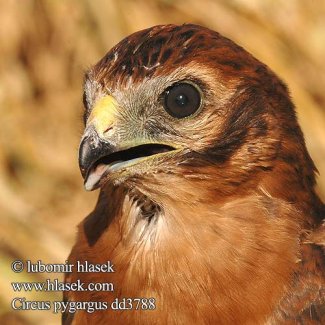 Montagu's
Harrier, Circus pygargus
Montagu's
Harrier, Circus pygargus
© Lubomir Hlasek, www.hlasek.com/
The juvenile plumage resembles that of the female,
but differs by the belly and under wing coverts which are not
spotted, but uniformly red brown in colour.
A melanistic form occurs regularly in this species. In this
form the male is much darker than usual, with a black
head, brownish black above and grey underparts. The melanistic
female is entirely chocolate brown except for
grey flight feathers. Partially melanistic morphs can also be
found.
The Montagu's Harrier has a particularly graceful flight, with
powerful and elegant wingbeats which give an
impression of buoyancy and ease. In true harrier fashion it
searches the countryside, flying low, and generally
holds its wings with a marked positive dihedral. |
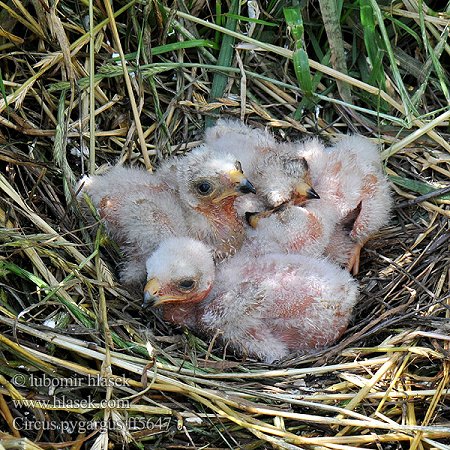 Montagu's
Harrier, Circus pygargus
Montagu's
Harrier, Circus pygargus
© Lubomir Hlasek, www.hlasek.com/
The Montagu's Harrier is a deceptively small
raptor, though it appears larger because of its large wing surface
compared to small body weight, which gives it a typically buoyant
flight. The female is larger than the male,
however this is not apparent in the field.
Wingspan: 97–115 cm, Length: 43–47 cm (tail: 16–18
cm), Weight (average): Male: 265 g and Female: 345 g.
Source: http://en.wikipedia.org/wiki/Montagu's_Harrier |

Montagu's
harrier - overview
Video credits ©
www.osfimages.com © Granada Wild Audio credits © Natural
FX
www.arkive.org
Northern
Harrier, No: Myrhauk, Circus cyaneus

Northern
Harrier, Circus cyaneus
© http://www.ecosystema.ru/
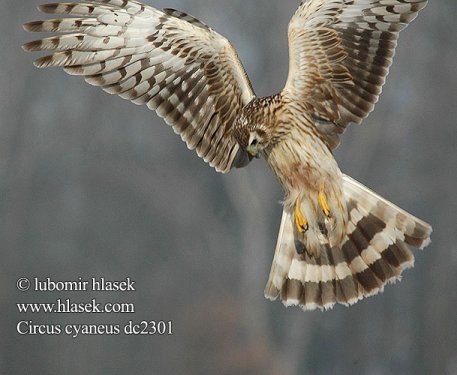
Northern
Harrier, Circus cyaneus
© Lubomir Hlasek, www.hlasek.com/
The Hen Harrier, Circus cyaneus, or Northern Harrier
(in North America) is a bird of prey. It breeds throughout
the northern parts of the northern hemisphere in Canada and
the northernmost USA, and in northern Eurasia.
This species is polytypic, with two subspecies. Marsh Hawk is
a historical name for the American form.
It migrates
to more southerly areas in winter. Eurasian birds move to southern
Europe and southern temperate
Asia, and American breeders to the southernmost USA, Mexico,
and Central America. In the mildest regions,
such as France, Great Britain, and the southern US, Hen Harriers
may be present all year, but the higher ground
is largely deserted in winter.
|
 Northern
Harrier, Circus cyaneus
Northern
Harrier, Circus cyaneus
© Lubomir Hlasek, www.hlasek.com/
.The Hen Harrier is 45–55 cm long with a 97–118
cm wingspan. It resembles other harriers in having distinct
male and female plumages. The sexes also differ in weight, with
males weighing an average of 350 g and females
an average of 530 g.
The male of the nominate race, Circus cyaneus cyaneus ,
breeds in Europe and Asia, is mainly grey above and
white below except for the upper breast, which is grey like
the upperparts, and the rump, which is white;
the wings are grey with black wingtips. The female is brown
above with white upper tail coverts, hence females,
and the similar juveniles, are often called "ringtails".
Their underparts are buff streaked with brown.
The female gives a whistled piih-eh when receiving food from
the male, and her alarm call is chit-it-it-it-it-et-it.
The male calls chek-chek-chek, with a more bouncing chuk-uk-uk-uk
during his display flight.
|
 Northern
Harrier, Circus cyaneus
Northern
Harrier, Circus cyaneus
© Lubomir Hlasek, www.hlasek.com/
This medium-sized raptor breeds on moorland,
bogs and (in Europe) farmland. The nest is on the ground.
Four to six whitish eggs are laid.
In winter, the Hen Harrier is a bird of open country, and will
then roost communally, often with Merlins
and
Marsh Harriers. There is now an accepted
record of transatlantic vagrancy by the American subspecies,
with a juvenile being recorded in Scilly, Great Britain from
October 1982 to June 1983.
This is a typical harrier, with long wings held in a shallow
V in its low, contour-hugging, flight. Hen Harriers hunt small
mammals and birds, surprising them as they drift low over fields
and moors. This harrier tend to be a very vocal bird while it
glides over its hunting ground.
Source: http://en.wikipedia.org/wiki/Northern_Harrier |
Western Marsh-Harrier, No: Sivhauk, Circus aeruginosus

Western
Marsh-Harrier, Circus aeruginosus
© http://www.ecosystema.ru/
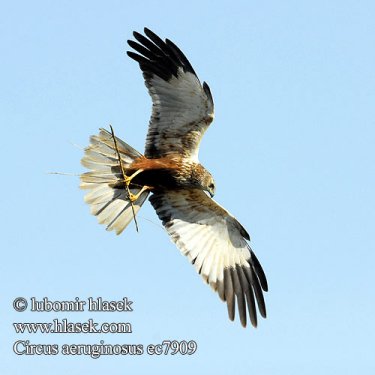
Western
Marsh-Harrier, Circus aeruginosus
© Lubomir Hlasek,
www.hlasek.com/
.The Western Marsh-harrier, Circus aeruginosus,
is a mid-sized harrier, a bird of prey from temperate and
subtropical western Eurasia and adjacent Africa. It is also
known as the Eurasian Marsh-harrier.
The Western Marsh-harrier is often divided into two subspecies,
the widely migratory
Circus aeruginosus
aeruginosus which is found across most of its range, and
Circus aeruginosus harterti which is resident
all-year in north-west Africa. |

Marsh harriers hunting ducks
Video credits ©
BBC Natural History Unit Audio credits © BBC Natural History
Unit © The RSPB 2003
The Western Marsh-harrier is 42 to 56 cm in length, and has
a wingspan of 115 to 140 cm. It is a large, bulky
harrier with fairly broad wings, and has a strong and peculiar
sexual dichromatism.
The male's plumage is mostly a cryptic reddish-brown with lighter
yellowish streaks, which are particularly
prominent on the breast. The head and shoulders are mostly pale
greyish-yellowish. The rectrices and the
secondary and tertiary remiges are pure grey, the latter contrasting
with the brown forewing and the black primary
remiges at the wingtips. The upperside and underside of the
wing look similar, though the brown is lighter on the
underwing. Whether from the side or below, flying males appear
characteristically three-colored brown-grey-black.
The legs, feet, irides and the cere of the black bill are yellow. |

Marsh harrier feeding chicks in nest
BBC Natural History
Unit
.The female is almost entirely chocolate-brown. The top of
the head, the throat and the shoulders have of a
conspicuously lighter yellowish colour; this can be clearly
delimited and very contrasting, or (particularly in worn
plumage) be more washed-out, resembling the male's head colors.
But the eye area of the female is always darker,
making the light eye stand out, while the male's head is altogether
not very contrastingly colored and the female lacks
the grey wing-patch and tail. Juveniles are similar to females,
but usually have less yellow, particularly on the shoulders.
Source: http://en.wikipedia.org/wiki/Western_Marsh_Harrier |
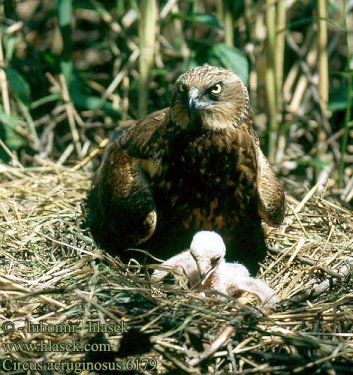
Western
Marsh-Harrier, Circus aeruginosus
© Lubomir Hlasek,
www.hlasek.com/
|




















